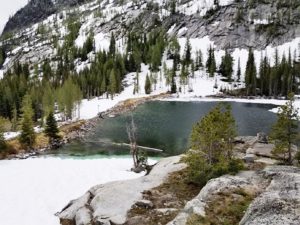
The Bitterroot National Forest has issued a Draft Decision Notice and Finding of No Significant Impact for the Canyon Lake Dam Access for Repair Project. The decision would authorize the Canyon Creek Irrigation District (CCID) to access the dam by helicopter, making approximately 32 round trip helicopter flights and to airlift motorized equipment and heavy, bulky construction materials needed to repair and stabilize the embankment on the dam, safely and effectively.
Anyone who has previously commented on the proposed project has 45 days following the publication of the draft decision to lodge an objection. The notice was published on September 15, 2019. The Forest received 12 comment letters. Eleven comment letters were supportive of the proposed action and one comment letter expressed concern that the project was not being conducted using primitive means.
Canyon Lake Dam is located on the Darby Ranger District of the Bitterroot National Forest within the Selway-Bitterroot Wilderness in the upper Canyon Creek drainage west of Hamilton. Distance to the dam from the trailhead is approximately 5 miles. The steep trail ascends over 2400 feet in elevation and crosses a steep, rocky slope within the last mile of the dam. Trail No. 525 is not recommended for stock use because of steep grades, rockslides with large voids, and sections of slick rock slabs. The 430-foot long, 22-foot high earth dam was constructed in 1891. The water stored in the reservoir is used to irrigate more than 1,000 acres.
According to the information in the draft decision, the dam is classified as a high hazard structure with the capability of causing damage to downstream property and environmental resources in the event of a failure. It could also present a threat to public safety if the dam failed.
In 2004, work was completed on the dam for the purpose of increasing inadequate spillway capacity, repairing failing outlet works, and addressing surface erosion problems along the upstream embankment. However, this project did not correct embankment stability problems and internal erosion or piping potential.
According to the draft decision, the rehabilitation project will correct deficiencies that have resulted in significant seepage through the dam embankment, which have been documented and monitored by Hydrometrics Inc. over the past several years during routine safety inspections.
In the past 12 years, three sinkholes have been repaired. Silty sand embankment soils are prone to piping (internal erosion). Localized piping and high seepage velocities can lead to development of more sinkholes and/or a total dam breach failure. The most recent sinkhole developed near the south abutment of the auxiliary spillway in 2017.
Helicopter access to the dam is requested to transport bulky equipment, and heavy construction materials needed to accomplish the repair work within generally accepted industry standards. It is not safe or feasible to physically pack this equipment and heavy construction materials in with stock.
The estimated number of helicopter flights (32) needed to complete the project is based on estimates from Hydrometrics Inc. and includes 11 flights for mobilization of equipment and materials, eight flights for resupply of construction materials, nine flights for demobilization and four additional contingency flights for unforeseen problems at this remote site.
According to the draft decision, primitive techniques were never utilized in the construction of critical elements of the dam, which include compaction of soils to a required density, installation of highly reliable mechanical elements (geomembrane liner) and batching or placement of high quality concrete or grout that meets design specifications.
But the technology used to construct dams in wilderness in the late 1800’s and early 1900’s, or even early 1960’s technology when the Wilderness Act was passed, cannot be used to repair and maintain the dams today because engineering designs have become more technically complex in order to meet both federal and state dam safety standards and construction quality control/quality assurance practices. Both the dam owner and their engineering representative are responsible for exercising the duty of reasonable care to protect their interests from legal liability.
“In the current litigious environment, it is essential that CCID pursue repairs since they have knowledge of embankment deficiencies (formation of sinkholes and excessive seepage). If the dam owner has knowledge of defective condition(s) and the dam failed as a result, then liability will likely ensue if remedial measures are not accomplished in a timely manner to mitigate the hazardous conditions,” states the draft decision.